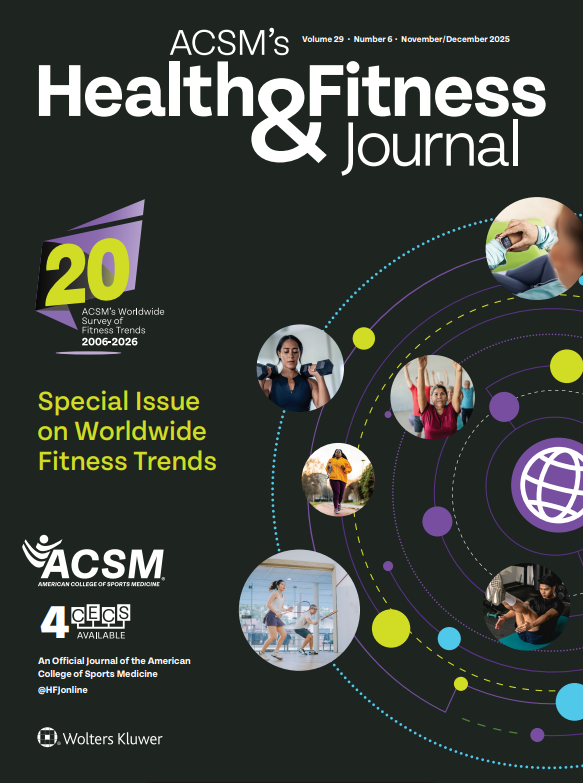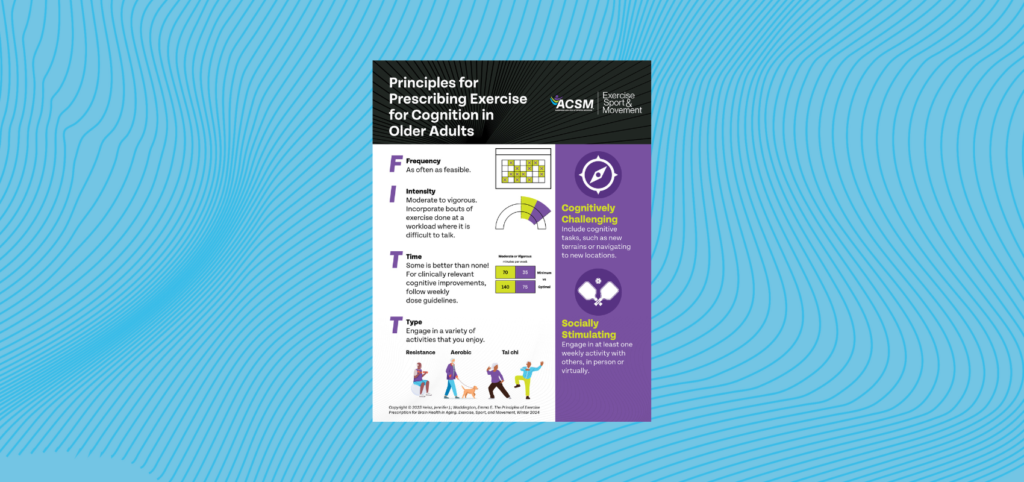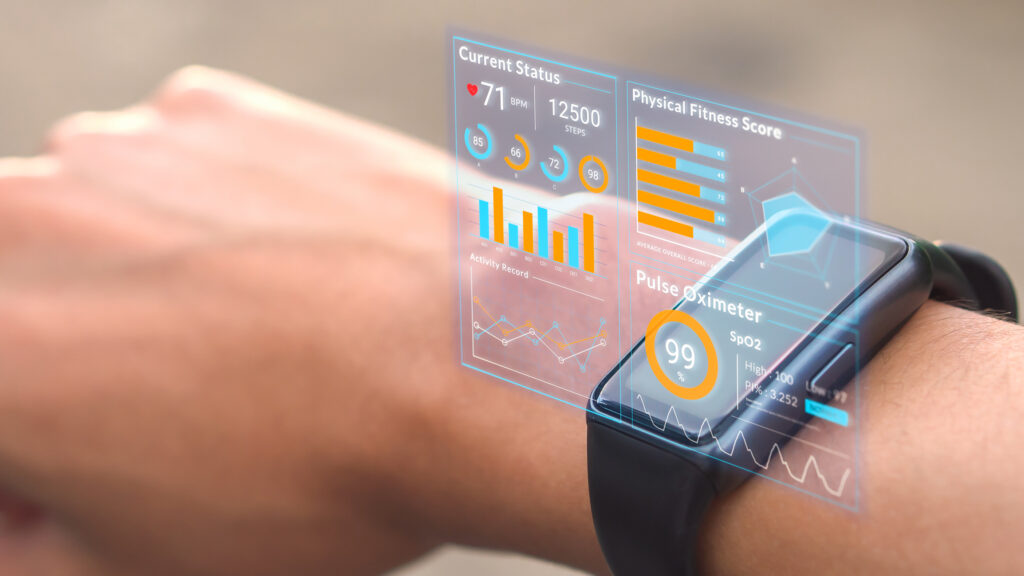


The results of the annual ACSM’s Health & Fitness Journal® worldwide survey guide fitness industry decision-makers with data collected from thousands of researchers and practitioners.
Now in its 20th year, the survey provides a long-term perspective of how the field has evolved, from early concerns about childhood obesity to the rise of wearable technology and medically integrated programs. This milestone marks a meaningful opportunity to reflect on the industry’s progress and thoughtfully consider its future direction.
Discover why muscle power—not just strength—is the real key to staying active and independent as you age. This article from ACSM’s Health & Fitness Journal® reveals how power declines faster than strength, why that matters for preventing falls and maintaining vitality, and how targeted training can help you stay “antifrail.” Perfect for fitness pros, health advocates, and anyone passionate about aging well, it offers practical, science-backed insights to keep you moving stronger, longer.
Wearable technology includes fitness trackers, smartwatches, heart rate monitors, and GPS devices that collect real-time and trend-based health data. Common metrics include heart rate, steps, speed, and distance. Advanced biosensors now capture additional indicators such as fall or crash detection, heart rhythm, blood pressure, blood glucose, and skin temperature. These tools can support behavior change through feedback, goal setting, coaching, training plans, and integration with other platforms and apps.
Roughly 36%-44% of adults own wearable technology, amassing a global market that is projected to be 186 billion by 2030.
SURVEY PERFORMANCE: Since 2016, Wearable Technology has consistently ranked #1, except in 2018 (#3) and 2021 (#2). It held a top three rank in nearly all professions and age-groups surveyed, reflecting its widespread appeal.
This trend addresses the unique physiological changes associated with aging, with a focus on maintaining or improving balance, muscle mass and strength, and mobility. The baby boomer generation includes 73 million Americans born between 1946 and 1964, all of whom will be over age 65 by 2030, intensifying demand for age-appropriate, evidence-based exercise options. According to the 2023 IHRSA U.S. Health & Fitness Consumer Report, adults ≥65 years now visit gyms and studios more often than any other age group.
SURVEY PERFORMANCE: With the exception of 2017 and 2022, this trend has appeared in the top 10 each year since the survey began. In the 2026 survey, it ranked highest among respondents ≥65 years, as well as Owners, Health/Wellness Coaches, and Group Exercise Instructors.
Obesity affects 42.4% of U.S. adults, while approximately 49% report actively trying to manage their weight. Most commonly, individuals do so through exercise, dietary changes, or medications such as GLP-1 receptor agonists. As the use of obesity management medications increases, structured exercise remains essential for long-term success. It uniquely supports metabolic health, preserves lean mass, and improves physical function. These outcomes are not consistently observed with medication alone.
SURVEY PERFORMANCE: Exercise for Weight Management ranks #3 for 2026, its highest position to date. It was ranked #4 in both 2025 and 2024, and #8 in 2023. The trend name was recently updated from “weight loss” to “weight management” to reflect a broader range of goals, including weight loss, maintenance, and gain.
Mobile Exercise Apps are digital platforms that deliver on-demand, scheduled, live-streamed, or recorded workouts, offering users convenience and flexibility to exercise anytime, anywhere. In 2024, more than 345 million people used fitness apps, generating more than 850 million downloads. Although usage and downloads peaked in 2021–2022, revenue has continued to rise as users maintain subscriptions. App users tend to be younger, female, college-educated, and living in urban areas, with lower adoption observed among older adults and individuals with limited digital literacy.
SURVEY PERFORMANCE: Mobile Exercise Apps rank #4 in the 2026 Fitness Trends, down from #2 in 2025 but maintaining a strong position. The trend previously ranked #7 in 2024, reflecting ongoing demand.
Development and Pilot Testing of a Telehealth Weight Loss Program | by Hales and colleagues, published in the Translational Journal of the American College of Sports Medicine
The History of Exercise Equipment: From Sticks and Stones to Apps and Phones| by Parrott and colleagues, published in ACSM’s Health & Fitness Journal®
Fitness Watches and Nutrition Apps: Behavioral Benefits and Emerging Concerns | by Scheid and Lupien, published in ACSM’s Health & Fitness Journal®
Ally with Your Fitness App: Help Others Maintain Motivation with the WHY-WAY-DO Framework | by Segar, published in ACSM’s Health & Fitness Journal®
This category includes programs designed to improve core stability, muscular endurance, mobility, coordination, and motor control through disciplines such as yoga, Pilates, and barre. Participation in yoga, Pilates, and mobility-focused classes rose by 27% between 2022 and 2024, driven largely by suburban boutique studios. As fitness and wellness sectors continue to converge, this trend has emerged as a foundational element of balanced programming that supports both physical function and emotional well-being, reflecting a broader shift toward physical well-being, social connection, and mindfulness.
SURVEY PERFORMANCE: Balance, Flow, and Core Strength ranks #5 for 2026, with strong performance across age groups and professional roles. After a pandemic-related dip in group participation, these formats have regained momentum alongside increased interest in holistic health and mind–body integration. In previous surveys, core training, yoga, and Pilates were listed separately but consistently ranked in the top 10 from 2007 to 2020. In 2026, this trend ranked highly among Personal Trainers and among respondents <25 and >55 years, highlighting its cross-generational appeal.
Robust evidence supports the positive impact of physical activity on mental health, including improvements in mood, stress resilience, and body image. Evidence supports that both aerobic and resistance training significantly reduce depressive symptoms, with the greatest benefits in individuals with mild to moderate symptoms. While not a replacement for clinical treatment (e.g., cognitive behavioral therapy), exercise offers a practical and scalable approach to improving mental health in both preventive and adjunctive contexts. Each year in the U.S., more than one in five adults report experiencing mental illness, reinforcing the importance of movement-based strategies that support emotional well-being.
SURVEY PERFORMANCE: Exercise for Mental Health ranks #6 in 2026, up from #8 in both 2025 and 2024. It placed in the top three for Owners, Program Managers, and Athletic Trainers, reflecting broad recognition of mental health as a focus across diverse professions.
Traditional strength training includes resistance exercises using free weights such as barbells, dumbbells, and kettlebells to improve muscular strength, endurance, and function. It is a key element of federal physical activity guidelines and plays an important role in maintaining bone density, metabolic health, and mobility across the lifespan. Despite these benefits, fewer than 30% of U.S. adults meet the recommended guidelines for muscle-strengthening activity.
SURVEY PERFORMANCE: This trend remains a consistent favorite, ranking in the top 10 for 17 of the past 20 years. In 2026, it ranked in the top three among Exercise Physiologists and among professionals with 21 or more years of experience.
The Do It Right Series appears in every other issue of ACSM’s Health & Fitness Journal®. The series on executing proper technique is written and demonstrated by Peter Ronai, M.S., FACSM, ACSM-CEP, ACSM-EP, EIM III, CSCS
This trend includes the use of real-time physiological data to individualize training, monitor recovery, and support long-term health. The emphasis is on how metrics such as heart rate variability (HRV), VO₂ max, sleep quality, and glucose levels are interpreted and applied to guide decisions. These insights allow professionals to adapt exercise programs based on metabolic and nervous system responses. In 2024, more than 70% of wearable users reported applying their output data to inform exercise or recovery strategies.
SURVEY PERFORMANCE: Data-Driven Technology is down one spot from 2025 but remains firmly in the top 10. It earned a top three rank among Strength and Conditioning Coaches, Personal Trainers, and respondents under age 45.
Adult Recreation and Sport Clubs include community-based fitness groups (e.g., running or cycling clubs) and recreational leagues for team sports such as basketball, soccer, or pickleball. These formats offer structured, social opportunities to be active outside traditional gym settings.
SURVEY PERFORMANCE: New to the top 20 in 2026, this trend reflects growing interest in activities that combine fitness with fun, flexibility, and social connection. It ranked especially high among Clinical Exercise Physiologists and Medical Professionals, suggesting expanding recognition of its value beyond traditional fitness audiences.
Functional fitness training includes strength, power, mobility, and endurance movements designed to improve physical performance in real-world activities. This modality enhances balance, coordination, and overall movement efficiency, and its versatility makes it appropriate for youth, adults, and older populations alike. Programs often emphasize compound, multiplanar movements such as squats, lunges, and carries that transfer directly to daily life or sport.
SURVEY PERFORMANCE: Functional Fitness Training ranks #10 in 2026, up from #12 in 2025. It has appeared in the top 20 every year since 2007, reflecting long-term relevance.

Stay ahead of the curve with the ultimate fitness industry forecast package.
Fitness professionals who lead the market don’t just follow trends, they anticipate them. The ACSM Worldwide Fitness Trends aren’t mere predictions; they’re the industry roadmap that top professionals and successful facilities use to make strategic decisions that drive growth and client results.

![]()
![]()
![]()




As you look around your home, you may spot devices like smartphones, tablets, smart TVs

Recent public health guidelines emphasize the importance of high-intensity interval training (HIIT) as an effective

Wearable technology takes #1 spot Technology applications in the fitness industry continue to build momentum